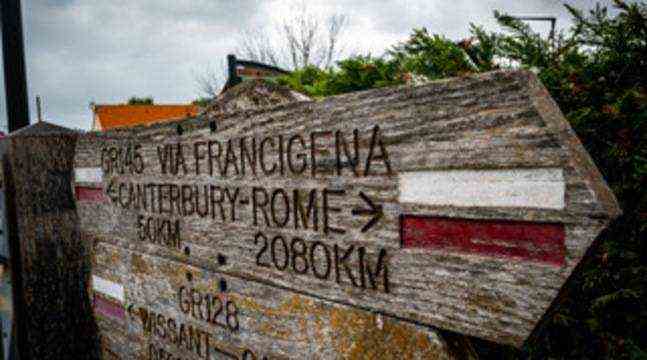Mining basin, belfries, Amiens cathedral … Will the Via Francigena soon have to be added to Unesco’s world heritage in the Hauts-de-France region? It is the dream of the European Association of Via Francigena Paths (AEVF), this pilgrimage route between Canterbury, in Great Britain, and Rome, in Italy.
This medieval road was taken in 990 by Sigéric, the Archbishop of Canterbury. The latter went to Rome to receive the pallium (a liturgical ornament) from the hands of the Pope. On his return, the clergyman recorded his stages in his “diary”.
The region on the way to Rome
In the Middle Ages, the Via Francigena (and its many detours) thus became a major axis of pilgrimage from north-western Europe to Rome, or even to the ports of southern Italy, making it possible to embark towards Jerusalem and the Holy Land.
This road logically passes through Hauts-de-France. From Calais, it follows the contours of the GR 145, to start first towards the south-west and Wissant, before branching off to the south-east and crossing Guines, Arras, Bapaume, in Pas-de-Calais, Péronne, in the Somme, Tergnier and Laon, in the Aisne.
“This Unesco file has been carried out since 2010, but above all at the initiative of the Italians,” indicates Luca Bruschi, director of the AEVF. We carried out the study with the cultural and scientific file identifying in particular the heritage elements on the route. ”
A planetary resonance to these paths
The next step is to obtain the political agreement of the Ministries of Culture of the four countries crossed: Great Britain, Switzerland, France, Italy. The deadline for a classification therefore still seems a long way off: three to seven years.
But the interest is obvious for Hauts-de-France. The Unesco label would give a planetary resonance to these paths. The belfries of Calais and Arras are already part of the heritage assets of the route, as are the necropolis of Notre-Dame-de-Lorette, Cap Blanc-Nez or the cathedral of Laon.
This is why the French section has been struggling, for a year, to mobilize the elected representatives of the territory “Some cities, such as Calais, Besançon, Arras are interested, confirms Martine Gautheron, vice-president. But it is especially the small municipalities that see it as an asset for their attractiveness. “
Arrival of the walkers on October 18
For the twentieth anniversary of their association, members of the AEVF and other walkers embarked on the entire course. They traveled through the communes of Hauts-de-France, meeting elected officials and local supporters, at the start of the summer.
The delegation of hikers should arrive, on October 18, in Santa Maria di Leuca, in the south of Italy, which has become the final destination of this Via Francigena in 2019. A spotlight on this path which welcomes, year after year, 50,000 walkers.

